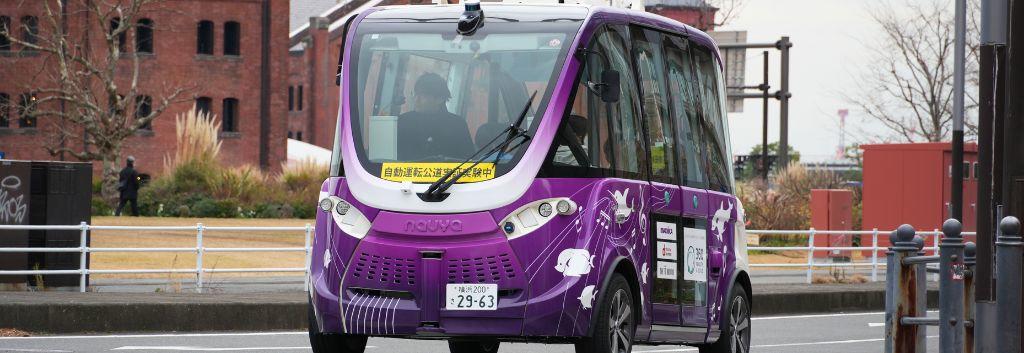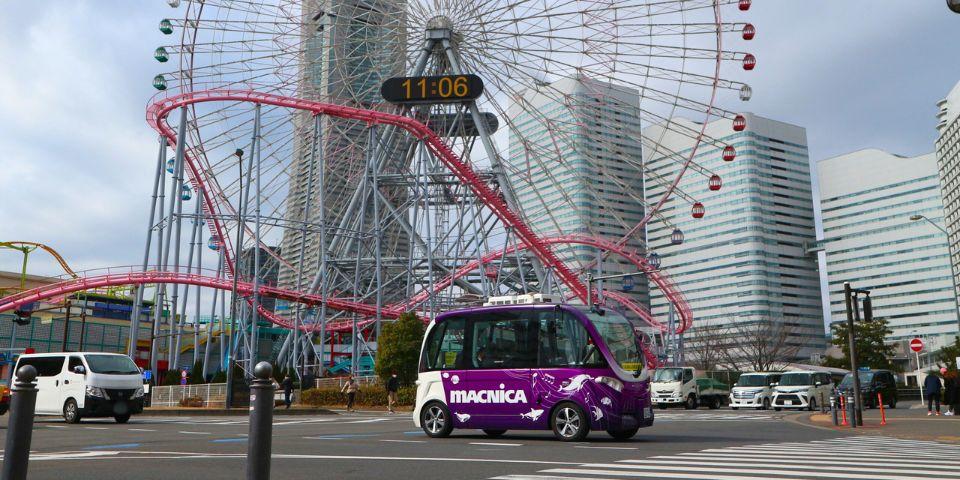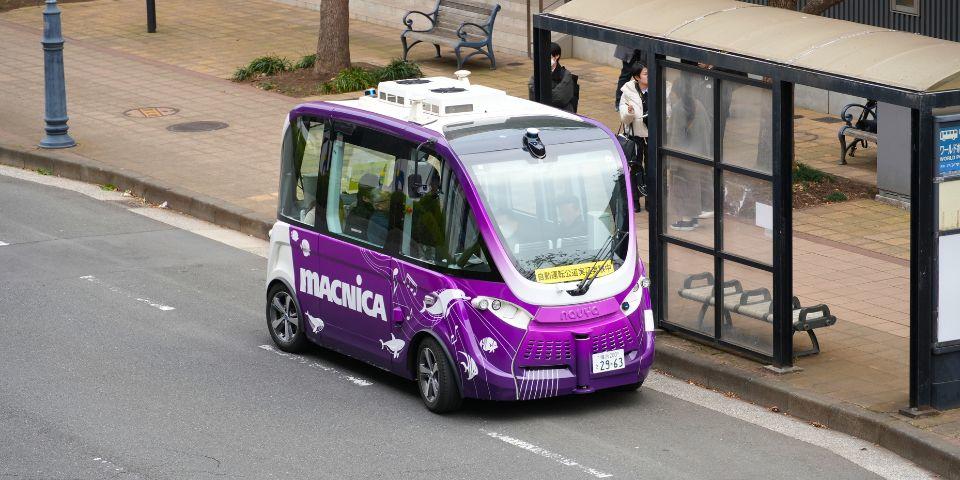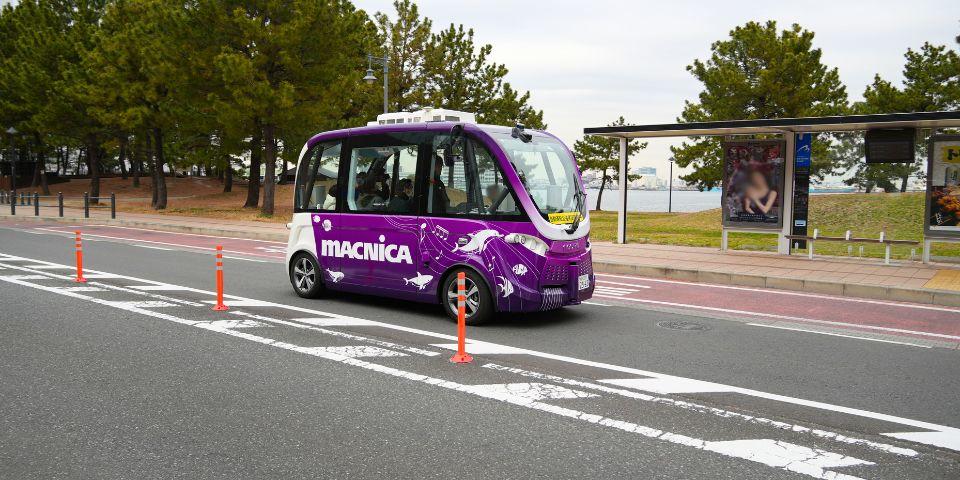
Macnica and the MM Smart Solution Consortium Executive Committee (hereinafter referred to as the MM Consortium) cooperated with NTT Communications to conduct a joint demonstration experiment of "5G x 3D sound-equipped entertainment autonomous driving EV bus running on public roads" in Minato Mirai for two days on February 3rd and 4th, 2024.
We would like to express our sincere gratitude to everyone who attended the test drives and trial sessions held during the demonstration experiment and those involved in the event for their valuable opinions and support.
This column provides a detailed report on the content and results of the demonstration experiment.
Background of the demonstration experiment

The MM Consortium is working with the Yokohama Future Initiative, a collaborative platform for creating innovation among industry, academia, government and citizens, to support the Minato Mirai 21 district as a future city where demonstration experiments of cutting-edge technologies can be conducted.
The current demonstration experiment was conducted as an adopted project of the "MM Smart Solution Program" implemented by the MM Consortium, with a view to implementing autonomous driving linked to 5G communications in the Minato Mirai 21 district.
The event was also held as part of the technology experience festival "YOXO FESTIVAL 2024 ~ Experience the Future in Yokohama ~" held during the same period. The festival brought together over 130 exhibition booths related to the future, including the latest space and drone technologies, robots, VR, and SDGs.
By running autonomous driving EV buses on public roads at the same time as the event where the entire city can experience future technologies and products, we will introduce autonomous driving EV buses not only to festival visitors but also to people passing through the city. This gave me an opportunity to get it.
In the future, autonomous driving in Minato Mirai, Yokohama EV Entertainment that allows passengers to enjoy a variety of content on board while the bus is operating, in conjunction with autonomous driving EV We will also explore the possibility of using it as a bus. DATTARUJIN Entertainment content provided by "M↔️M Sound Entertainment Tour Utilizing Japan's first self-autonomous driving entertainment electric bus on public roads This resulted in us implementing the following.
Details of the demonstration experiment
In this demonstration experiment, the vehicle boarded and disembarked at the World Porters bus stop in front of Unga Park Station, which is a sightseeing spot tour bus stop for the Akaikutsu bus, and traveled a route that covered a distance of approximately 1.4 km around the Shinko area, taking approximately 20 minutes to complete.
<overview>
schedule: 2024 Year 2 Month 3 Sunday (Saturday), 2 Month Four Sunday 2 Days
* During the same period, YOXO FESTIVAL 2024 This was implemented as part of the "Experience the Future in Yokohama" project.
Operating area: Approximately 10 minutes from the bus stop "World Porters" of the sightseeing spot tour bus "Akai Kutsu" 1.4km (about 20 15 minutes) Route around the Shinko area
Vehicles: autonomous driving EV bus" ARMA”
Capacity: Maximum 7 Name (Maximum Speed 18km/h)

autonomous driving EV bus uses the autonomous driving vehicle "ARMA" manufactured by Gama (formerly NAVYA).
ARMA is an EV version (electric vehicle) with a maximum speed of 19 km/h, and has no steering wheel, accelerator, or brakes, and can autonomously drive along a preset route while checking the safety of its surroundings using on-board sensors. In this experiment, the vehicle traveled at an average speed of about 15km/h.
The interior of the ARMA bus is equipped with a system that allows passengers to enjoy immersive sound using Sony's 360 Reality Audio surround sound technology. By playing music and the latest information inside the bus, autonomous driving EV bus has been given the element of an entertainment tour. By allowing passengers to enjoy music inside the bus on the way to the live venue, the travel time to the venue can also be made into entertainment.
In this demonstration experiment, remote monitoring was carried out using Macnica 's remote mobility management system "everfleet." At Macnica booth in the Yokohama Hammerhead complex along the route, a remote monitoring display using this everfleet was set up, and measures were implemented to inform visitors of ARMA 's operating status.
In addition, the video transmission from the camera installed on ARMA utilizes the "Network Customization" network provided by NTT Communications. Quality verification was also conducted to determine whether stable video transmission was possible using the 5G communication network.
Demonstration experiment
Demonstration experiment results
<Regarding social acceptance>
For this demonstration experiment, the number of customers who could experience the experience was limited, so we conducted a pre-application process. However, we received 1,157 applications for 150 spots, which indicated high levels of interest from customers not only in autonomous driving but also in combining it with content that enhances the experience value.
We received a variety of feedback from customers who actually rode the train. Not only did they feel that the combination of music content improved the experience, but many also called for the practical application of Level 4 operation using autonomous driving vehicles to be realized in other regions as well.
In addition, since this demonstration experiment was held on a Saturday and Sunday, there were many test drives by families with children, and the children asked interesting questions about the autonomous driving vehicle and its driving mechanism, and took photos and videos to observe the vehicle. I felt that doing things like doing things has a positive impact in terms of improving IT literacy.
<Regarding driving/operation aspects>
It was also found that service times vary depending on the number of vehicles parked on the street and the number of pedestrians using the crosswalk. The route was about 1.4 km long and took about 20 minutes to travel, but depending on the road congestion, in some cases it took about 10 minutes. In busy conditions, it may take longer than 20 minutes.
In addition, along the driving route, there are problems such as ``on-street parking,'' ``a crowded traffic environment on main streets,'' ``a large number of pedestrians coming and going near the red bricks,'' and security guards who watch over the safety of pedestrians crossing the road, which cause vehicles to overflow. Many issues were identified in terms of the driving environment and safe operation of autonomous driving vehicles, such as sudden stops.
The in-car audio system provided three-dimensional sound (music and information) that seemed to rain down from above. Even at fairly loud volumes, the sound did not leak outside the vehicle, making it a practical yet successful way to turn an autonomous driving bus into an entertaining experience.
Future prospects

Through this demonstration experiment, Macnica will not only solve the technical issues of autonomous driving without a driver, but also develop a business model for verifying and implementing the entire business model of autonomous driving EV buses. Construction will continue in this region.
At the same time, we will support innovation in a wide variety of industries that utilize the potential of the city and region, such as by operating autonomous driving electric buses with enhanced entertainment value. We will work hard to form a business ecosystem and plan to widely deploy cutting-edge urban development in the Shinko district.
Inquiry
Macnica supports the practical application of autonomous driving in various regions and facilities. If you have any questions or concerns regarding autonomous driving, please feel free to contact us below.
